Immersion or stationary blender: which is better and what to look for when choosing + buyer reviews
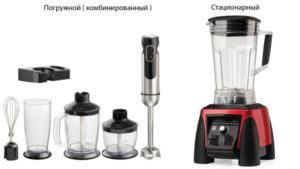 A huge number of its varieties have been invented for home work.
A huge number of its varieties have been invented for home work.
And to facilitate work in the kitchen, speeding up the process and the appearance of the possibility of cooking a variety of dishes, a lot of kitchen household appliances have been invented.
One of these devices is a blender.
Contents
What is and what is a device?
Blender is an electric household kitchen appliance that allows you to quickly chop foods, make ice, prepare a puree or sauce, whip a drink or mousse. Blender can be stationary and immersion.
Stationary blender is placed on the table, rather independently works, requires minimal supervision, immersion - at work need to be kept in hand, requires the direct participation of man, put it on the table will not work (with rare exception), you can only put.
They also differ in the placement of products with respect to the kitchen device itself. In a stationary blender products and ingredients are placed inside it, the immersion - on the contrary, the blender is placed inside the container with the products.
There is only one device, but there are two varieties. Which one is right for a certain kitchen job, and which one won't do? Which blender will make a big drink, and which one will make a portion of baby puree for a child's lunch? Which device is worth buying for daily use, and which one - for occasional use? Let's try to find out.
What do you need it for?
With a stationary blender you can process a fairly large volume of products, limited only by the volume of the bowl and the desire of the cook. In general, this device requires minimal human intervention, you should only fill the bowl with the right ingredients, press the power button and, after processing the products, timely turn off the device.
But it is not possible to grind small amounts of food (for example, a few garlic cloves) with this kind of appliance. When choosing to buy this blender, you should consider that it will need to allocate a certain place on the kitchen table, or remove the bowl and store in the kitchen cabinet in disassembled form, as this blender is quite large in height and not every kitchen furniture will fit as a whole.
Therefore, this type of device is recommended to buy those who cook large portions for a large family or guests and has a spacious work surface of the table in the kitchen.
Trading networks offer a wide range of stationary blenders at a variety of prices. You can buy the device at a price of 1000 to 20000 p.
The cost depends on:
- Completeness.
- The power.
- The material of manufacture.
- Country of manufacture.
- Manufacturer.
- Brand of the product.
- The status and, accordingly, the seller's markup.
But with an immersion blender you can prepare small portions of food - a glass of smoothie or a bowl of puree soup. It can be used with interchangeable attachments and in any container, not just those that are often sold with this type of blender.
It is quite compact and, having bought such a blender, it can be easily stowed on any kitchen shelf or hung on the wall on a special holder, which comes with some models, it does not require much space for storage.
If you often have to prepare small portions of purees, smoothies or shakes (for example, a family has a small child), or the size of the kitchen table is small, then buying this type of blender will be the right choice. The problem with using it may be the need to constantly hold the blender in your hands when working, in some cases it is tiring. The process of food processing (with rare exceptions) is almost always accompanied by splashing.
This type of kitchen equipment is cheaper than stationary models and is sold at a price of 450 to 8500 p. Cost is affected by the same pricing factors as stationary blenders.
Immersion blender
An immersion blender is a hand-held kitchen appliance with an elongated body with an 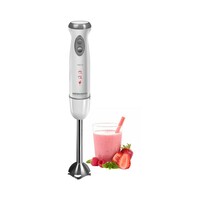
The undeniable advantages of the immersion blender should include:
- Mobility, it can work in any place where there is electricity and in any container.
- There are models of immersion blenders, working on batteries, which allows, when preparing a dish, to move around the kitchen or around the house, without being tied to an electrical outlet (the duration of autonomous operation is limited to 20-30 minutes and the device must be frequently recharged). This feature of the wireless device is indispensable if it is necessary to supervise small children.
- Immersion blenders are not difficult to care for, they are easy to clean.
- They can be simply and quickly prepared for operation.
- During the cooking process, you can change the angle of the device, thereby changing the position of the blades, if necessary.
Other disadvantages of immersion blenders include:
- The need to hold it in your hand and press the button constantly during the cooking process.
- Short operating time of cordless models.
- Splattering during operation.
- Difficulty in obtaining a homogeneous consistency of the prepared dish, especially if it is cooked in a large dish.
The ability to cook different products depends on several characteristics - for example, it is the power and speed of rotation. The power in immersion blenders can be from 120 to 1500 watts, and the higher it is, the wider the list of products that can be processed with this electric appliance, the longer the operating time without interruption, the faster the dish is prepared. Rotation speed of modern devices varies from 10000 to 19000 rpm, and the number of speeds in different models can be from 1 to 25.
Most models have a function to adjust the speed. By turning the special knob, or by increasing or decreasing the pressure on the button, you can increase or decrease the speed of the device. Some models have a button "turbo mode", when you turn it on, the device starts working at full power, but you can use this button only for a very short time. The higher the speed of rotation, the finer is the grinding of the processed products.
The range of dishes that can be prepared with an immersion blender is incredibly vast, it is:
- Sauces.
- Cream soups.
- Liquid dough, such as for pancakes.
- Stuffing of meat or fish.
- Pates.
- Salads.
- Cocktails and smoothies.
- Vegetable purees or stews.
- Baby food in the form of a puree of any ingredients.
- You can chop nuts, garlic, spices, ice or herbs, frozen foods.
Stationary blender
The stationary blender consists of an electric motor - blender drive, built into a stable body, on top of which a narrow tall bowl, similar to a jug with a pusher and a lid, is dressed. Inside the bowl is a paddle blade, which, when the motor is turned on, grinds the food put into it.
There is a kind of blender - a blender-cooker with a built-in heating element. Such a kitchen appliance can, in addition to chopping products, boil porridge, soup and grind its ingredients into a puree, with its help you can prepare meat or liver pâté, boil, not only mix sauce or vegetable mousse. This type of blender comes exclusively with a metal bowl, which, after cooking a hot meal, keeps warm for several hours.
Completion in stationary blenders can be different - from the simplest, consisting of a base and a bowl, to the presence of a set of mills, juicers, whiskers, interchangeable blades of different designs with a different number of blades, a few removable bowls, which can both cook and store prepared food and drinks, which is certainly an advantage of such models.
The advantages of stationary models of blenders can also include:
- Independent operation, they do not need to be held in the hands.
- The convenience of cooking large amounts of food.
- Grinding of products is carried out in a closed container, without splashing, due to which the kitchen remains clean.
- Easy to use.
- Availability of an overheat protection function, which automatically shuts off the appliance in the event of a dangerous situation.
- Thanks to the self-cleaning function, the blender is easy to care for.
Also, this type of blender is quite noisy, the emitted sounds can be unpleasant for others, this feature of the device is also a disadvantage.
Sometimes the need for a separate place on the table is considered a disadvantage of the device, but the blender model, matching the design to the kitchen environment, can serve as its decoration, so do not consider this feature a negative trait.
Different models of stationary blenders are sold with bowls of different volumes, from 0.3 to 2.0 liters. The larger the capacity of the bowl of the blender, the more products can be processed in one go, which is important if the dishes are prepared for a large number of people.
Bowls are made of different materials, very often they have a measuring scale for ease of use.
- Metal bowls are the strongest, but they are also the most durable.
- The next best working qualities are bowls made of tempered impact-resistant glass. They can withstand high temperatures and absolutely do not absorb odors, but in the case of a fall or impact, they can break.
- The cheapest option - these containers are made of plastic. They do not break, but gradually, in the process of operation, they get covered with small scratches and become muddy.
Stationary blenders differ in the capacity of the engine, which determines the capabilities of the device, and the number of revolutions. Modern devices are available with power from 200 to 3000 watts, speed up to 35000 rpm, which can be smoothly adjusted with a special knob on the body. The more powerful the device, the more its possibilities for processing products, the longer it can work without interruption.
With the help of a stationary blender can be prepared, and in considerable quantities:
- Sauces and gravy.
- Mashed soups.
- Juice from chopped vegetables or fruits with a special nozzle.
- Milk or fruit smoothies.
- Smoothies.
- Homemade mayonnaise.
With some experience, you can prepare salads, if experience is not enough - vegetable stew or puree. Powerful device will be able to crush ice, grind hard spices or fruits.
The speed of rotation above 24000 rpm allows you to achieve an emulsifying effect, in which the smallest particles of ingredients that do not normally mix with each other (such as oil and water), evenly mixed, and you can prepare delicate sauces or pastry cream, which do not disintegrate over time.
Conclusion and implications
When comparing the two types of blenders, it becomes clear that each has some advantages and some disadvantages. Immersion blenders are inferior to stationary blenders in terms of power and rotation speed. If you compare immersion blender models and stationary blenders of the same power, the stationary blender will win in such a comparison, primarily because of the ease of use.
The availability of stationary blenders closed bowl for food processing, which eliminates splashing of ingredients in the kitchen, is a plus. But the ability of an immersion blender to work in any container, not just a special bowl, is an advantage over a stationary blender. Also a plus of the immersion blender can be called a considerable number of a variety of interchangeable attachments, sold with most models.
Therefore, when deciding to buy such a kitchen appliance as a blender, the buyer should be guided by their own requirements for abilities and capabilities of the device, to know how often he will use this type of kitchen equipment, in what volumes and what exactly is supposed to cook and, accordingly, choose a kitchen helper.
Customer Reviews
Helpful video
In this video you will learn which blender is better to choose - an immersion blender or a stationary blender:



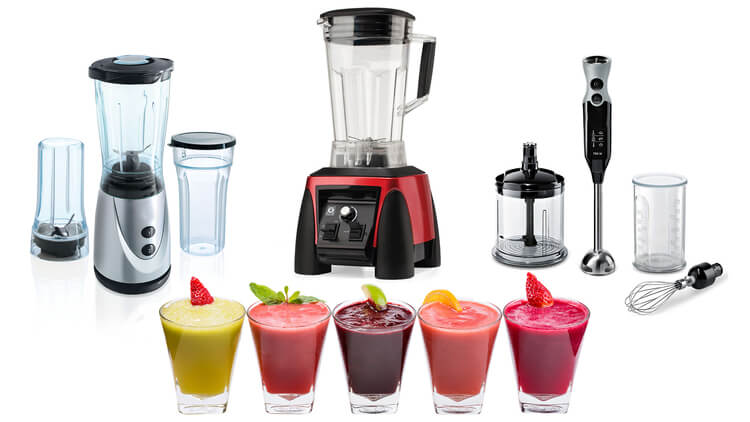
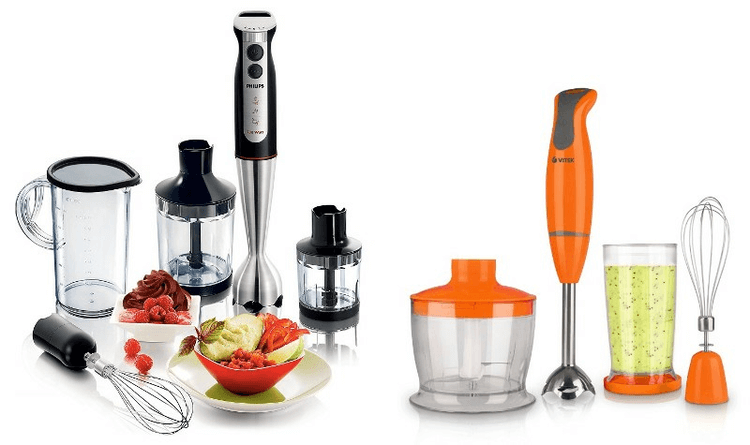

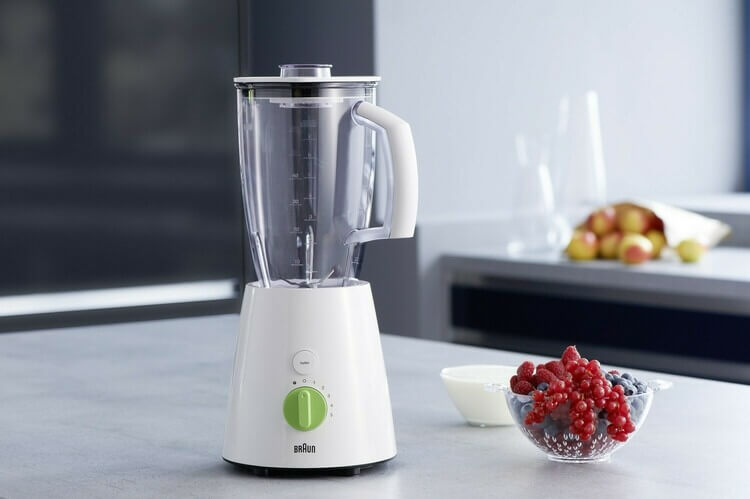


I have an immersion blender, I have been using it for four years and I am not disappointed with my choice. The blender works in two speeds, which allows you to make juices with pulp, soups, purees, quickly whip great cocktails. The blender is very easy to use: both the length of the cord is sufficient, and it is easy to clean. I think that for any housewife, an immersion blender is a universal find.
The Braun MR 300 simple immersion blender has been in my kitchen since late 2012. Two speeds, I use it not only for soft foods, but also for harder foods. For example I cook zucchini caviar for the winter, but I soften the pieces under the lid with a little water. I am convinced that the immersion blender is convenient for cooking stuff for the winter. Washes quickly and easily, compactly stored.
Having in my arsenal of 2 types of blender (and stationary and immersion), I am clearly in favor of the stationary. It can be turned on, and while it works, prepare something else for chopping, unlike the submerged one, because you have to hold it by pressing the button. And it is not necessary to look for a special bowl to avoid splashing. Of course, it is convenient with an immersion blender when, for example, you want to make soup puree, the volume of which is larger than the bowl of a stationary blender, then the immersion blender wins here. You can just immerse it in a pot and let it do its job, but that only applies to soup (well, at least in my cooking). I give my vote for the stationary one all the same)